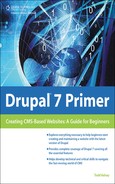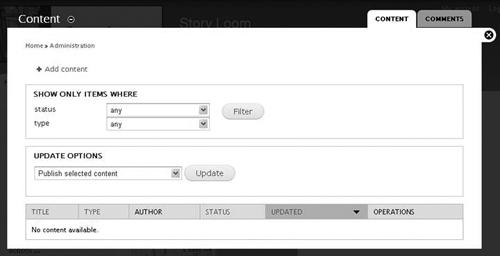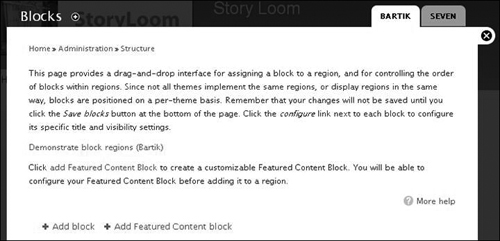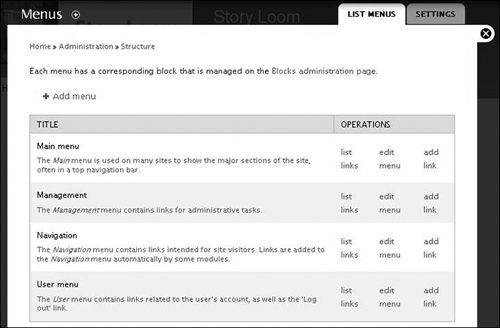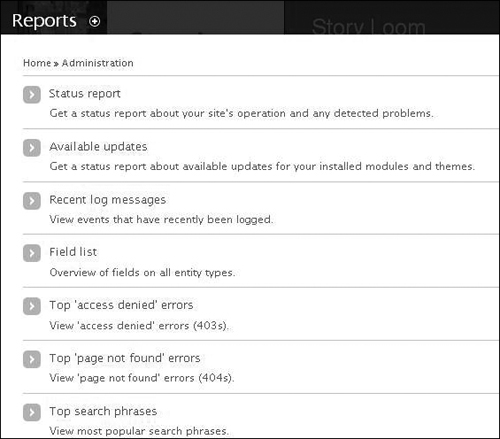The Standard Drupal 7 Interface
This section, and the rest of the chapter, discusses the standard Drupal 7 interface. Regardless of whether you use the Admin module or not, the basic functions in Drupal 7 will be the same. Here you’ll see the series of options that appear at the top of the screen:
Dashboard: At a glance, customizable view of site activity
Content: Create/manage content
Structure: Configure blocks, menus, etc.
Appearance: Themes, etc.
People: Create/manage users
Modules: Install, enable, configure
Configuration: General site configuration
Reports: A series of reports for administrators
Help: Help documents and how-to articles on a variety of topics
Home
The Home button will return you to the home page of your site:
![]()
Sometimes, it changes to an icon with a wrench:
![]()
That’s when you’ve accessed an administrative function. To get the home icon back, just close the window of whatever admin function you’re using, by clicking the x in the upper right:
![]()
You can also click the icon to get an additional menu for navigating Drupal:
![]()
A pop-up will appear with various functions—for example, you can click the “Administration” link:
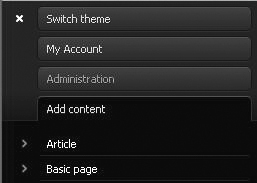
And a variety of the Admin functions will appear. You can click the + signs and > signs to access additional features (and then you can click “-” to collapse). To get out of this link area on the side, click the x (see Figure 10.1).
Figure 10.1. Close the list of links on the left, with the x option.

The “Drawer” sometimes pops up and has additional features. You can access it/collapse it by clicking the upward-facing triangle all the way at the right of the interface:
![]()
Roll over and click it:
![]()
There’s also an “Edit shortcuts” link on the drawer.
Dashboard
The Dashboard is meant to be an at-a-glance area where various functions could be added (as people write them), as shown in Figure 10.2. This might include things like site traffic. Depending on what version of Drupal you are installing, there will be widgets you can add under “Customize dashboard.”
To exit the Dashboard (and any other admin function), click in the x in the upper right-hand corner. You can also click the top-level menu choices (Content, etc.)
Content
The Content area is for adding conventional content, such as articles, pages, and so on (see Figure 10.3). We’ll discuss more about content in Chapter 11, “Easy Expansion—Adding Content and Menus.”
Structure
The Structure section allows you to work with various features that impact structure (see Figure 10.4). The two you’re probably most likely to use are Blocks (see Chapter 7, “Configuration”) and Menus (see Chapter 11, “Easy Expansion—Adding Content and Menus”).
Figure 10.4. Structure—the most commonly used features are probably Blocks and Menus.
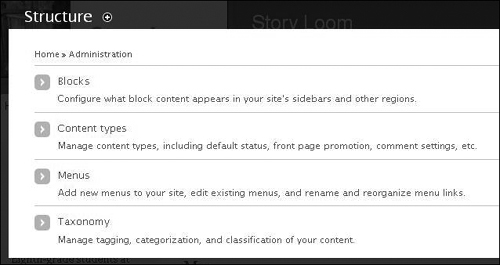
Blocks
Drupal allows you to easily reorder and adjust the placement of content on pages, through Blocks (see Figure 10.5). For more information, check out Chapter 7.
Content Types
This feature allows you to adjust the kinds of content that can be added to the site (see Figure 10.6). It is generally for advanced users.
Menus
Menus allows you to create and manage the basic organization of how people get around on your site (see Figure 10.7). See Chapter 11 for more information.
Taxonomy
Taxonomy is a way to manage categorizing content. It’s generally for advanced users; see the Help section.
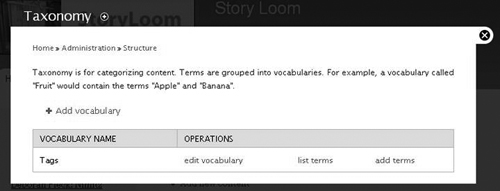
Appearance
The Appearance section has to do with adjusting and installing themes, which provide you with an easy way to change the “look and feel” for your site (see Figure 10.8). See Chapter 7 for more information.
Figure 10.8. Appearance is where you work with Themes, to affect the look and feel of your site.

People
The People section allows you to create and manage users (see Figure 10.9). Drupal lets you add users manually and adjust things that they can do (such as helping with your website). And you can have a community website, where people you don’t necessarily know can still join the community. This section helps you to manage and define “roles” so you can decide what you want to give people access to. See the “Reviewing Permissions” section in Chapter 7.
Modules
The Modules section is where you install, enable, and configure modules, which add various features to your site (see Figure 10.10). Modules are covered in several chapters in this book, including Chapter 12, “Modules to Simplify Content Creation.”
Figure 10.10. Modules are at the core of the Drupal CMS. There are many modules that you can use for free to add features to your site.
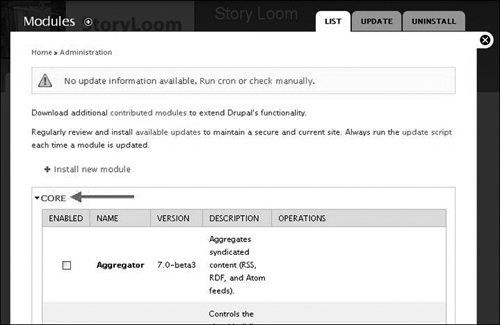
Configuration
The Configuration section of the site has a variety of panels that you can use to adjust settings on the site. There are some sections, such as People or System, which you may use more often than others. But just like the overall Admin interface, it’s helpful to wander through them, to have an idea of what’s going on “under the hood.”
People
The People section within Configuration covers some settings for users, such as default behavior, which means the default settings that people have when an account is created. It can be helpful to adjust things here so that you don’t necessarily have to manually adjust them every time a new user registers or you create one.
IP address blocking is a spam management feature where you can block specific addresses. (Sometimes, spammers will sign up and you might want to block them.)
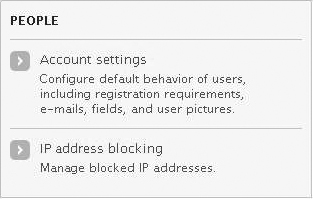
Content Authoring
Content authoring allows you to adjust some format information. It’s worth exploring, but is probably used more by advanced users.

System
The “Site information” link is probably the most common one that most people will use, to adjust some basic settings. It’s definitely worth exploring. The other options are more advanced. Google Analytics will only appear if you have the module installed and enabled.
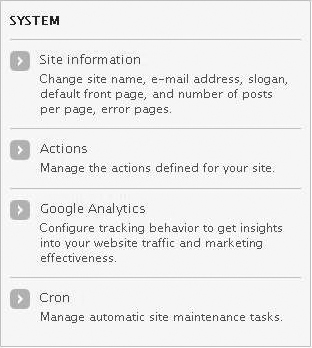
Media
These settings have to do with files and image management; they are generally for advanced users, when you install particular modules.
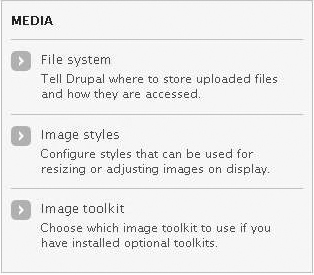
User Interface
Here are some basic settings for the interface, which may be useful to investigate if you end up using Drupal a lot.
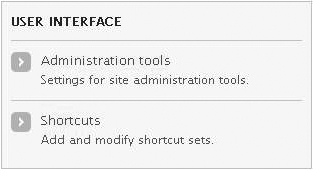
Search and Metadata
The Search and Metadata features will be most helpful to sites with a fair amount of content, or those who are interested in search engine optimization. Search engine optimization is a process for trying to get higher search results on Google, to help make it easier to find your site, for promotional purposes.
SEO
If you’re interested in SEO, try reading SEO Made Friendly (see Amazon) or reading http://en.wikipedia.org/wiki/Search_engine_optimization.
For example, you can see the way that addresses appear on your site. Even if you aren’t interested in SEO, you will probably want to try enabling Clean URLs. Instead of having addresses that end in /node/154, etc., you can have them end like “story/articletitle,” “news/blog-post-121410,” so that the name of the address for content is more self-evident, which can help when people make links (and with SEO). To enable clean URLs, click on the “Clean URLs” link, run the test, and enable Clean URLs. If it doesn’t work yet, you might need to wait until Drupal 7 is updated.

Development
This section has features for advanced users.
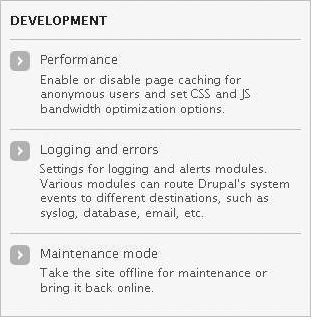
Regional and Language
This section allows you to adjust region and language settings. (Some language settings may not appear unless relevant language settings are adjusted.)
If you’re interested in making a website in different languages in Drupal, check the Language section on www.drupalprimer.com.

Web Services
This section allows you to adjust RSS settings; for advanced users.
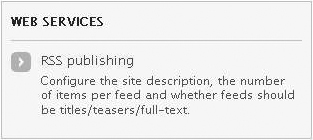
Reports
This section allows you to view a series of reports (see Figure 10.11); sometimes, Drupal will automatically display links to certain reports when you log into Drupal, if something needs attention. But you might want to check Status Report and Available Updates to see what they’re like. The more content you have on your site, the more interesting that “Top search phrases” might be to view.
Help
The Help section has some basic information, and a few helpful links (see Figure 10.12).
There’s also basic information on a variety of help topics:

